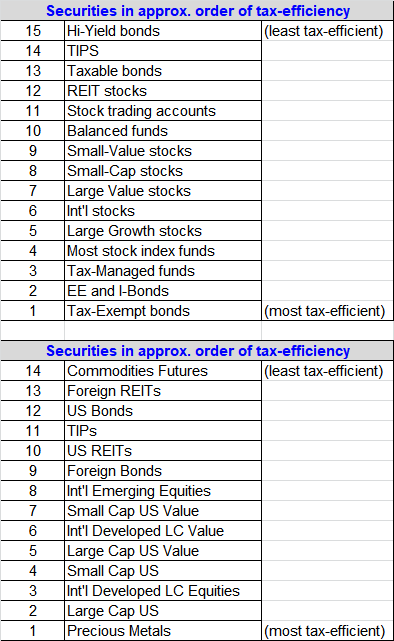SecondCor521
Give me a museum and I'll fill it. (Picasso) Give me a forum ...
Hi all.
I don't know a whole lot about bond mutual funds.
Suppose there exists an investor who has some money lying around in a taxable account. Federal tax rate of 22%, state tax rate of 5.8% with the typical rule where USGO is state tax exempt. No real plans for the money; it's sort of a cash reserve in case there is a big spike or one-off expense. The investor is well capitalized (~1.8% WR) and moderately aggressive risk-wise (~70/30 overall).
Currently the money is split about 46/54 between VFMXX and VBTLX.
VFMXX seems to be mostly invested in short term treasuries and is paying about 4.5%. As such, it seems like it will track short term rates with little to no lag.
VBTLX has more mid-term government paper and some investment grade corporates. Duration of six-ish years. Currently paying 4.3% or so. It seems like if interest rates drop in the future, the return on this fund would go up in the short term (because it would then be holding intermediate bonds paying higher interest) and then drop after a while (because those bonds would mature and be replaced by lower interest rate bonds).
Most people I know seem to think that rates may go somewhat higher in the near term, then level off and then drop off if inflation is deemed tamed and a recession starts. That's sort of what I think, but I'm pretty low confidence on the timing, direction, and duration of any of that - pretty much nobody expected SVB to collapse two weeks ago, for example.
Setting aside other potential investments (precious metals, CDs, MYGAs, individual bonds, etc.) and only focusing on these two funds:
1. Is my understanding of these two funds approximately on point?
2. Any suggestions regarding considerations between how the money is allocated between those two funds that the investor should consider?
Thanks!
I don't know a whole lot about bond mutual funds.
Suppose there exists an investor who has some money lying around in a taxable account. Federal tax rate of 22%, state tax rate of 5.8% with the typical rule where USGO is state tax exempt. No real plans for the money; it's sort of a cash reserve in case there is a big spike or one-off expense. The investor is well capitalized (~1.8% WR) and moderately aggressive risk-wise (~70/30 overall).
Currently the money is split about 46/54 between VFMXX and VBTLX.
VFMXX seems to be mostly invested in short term treasuries and is paying about 4.5%. As such, it seems like it will track short term rates with little to no lag.
VBTLX has more mid-term government paper and some investment grade corporates. Duration of six-ish years. Currently paying 4.3% or so. It seems like if interest rates drop in the future, the return on this fund would go up in the short term (because it would then be holding intermediate bonds paying higher interest) and then drop after a while (because those bonds would mature and be replaced by lower interest rate bonds).
Most people I know seem to think that rates may go somewhat higher in the near term, then level off and then drop off if inflation is deemed tamed and a recession starts. That's sort of what I think, but I'm pretty low confidence on the timing, direction, and duration of any of that - pretty much nobody expected SVB to collapse two weeks ago, for example.
Setting aside other potential investments (precious metals, CDs, MYGAs, individual bonds, etc.) and only focusing on these two funds:
1. Is my understanding of these two funds approximately on point?
2. Any suggestions regarding considerations between how the money is allocated between those two funds that the investor should consider?
Thanks!

